Bereavement leave is the basic means to support your team during one of life’s most challenging moments. And though it’s not a legal requirement in most parts of the United States, there are some state-specific bereavement leave laws to comply with.
Whether you’re revamping your company culture or just want to minimize legal risks, understanding these laws is a must. So, in this guide, we’re diving deep into everything you need to know about them, cutting through the legal jargon, and giving you clear, expert advice to help you manage this sensitive issue with empathy and efficiency.
Let’s get started, shall we?
US Federal Regulations on Bereavement Leave
There are two primary federal laws in the United States that regulate employees’ work and leave time. However, none of them mandates employers to provide bereavement leave:
- Family and Medical Leave Act (FMLA): This law might be your go-to for a variety of family and medical-related types of leave, but when it comes to bereavement leave, it doesn’t exactly step up to the plate. The FMLA allows eligible employees to take up to 12 weeks of unpaid leave for certain family and medical reasons, but bereavement isn’t explicitly one of them. However, some employers might allow you to use your FMLA time for bereavement on a case-by-case basis.
- Fair Labor Standards Act (FLSA): This one is primarily about wages and hours rather than leave. The FLSA doesn’t require employers to provide bereavement leave, either paid or unpaid. Essentially, there’s no federal mandate here, which means it’s often left to company policies.
Bereavement Leave Laws by State
While federal law doesn’t mandate bereavement leave, a handful of states have stepped up to ensure that employees have time to grieve and handle affairs after a loved one’s passing.
Let’s dive into the specifics of these states:
Oregon
Oregon is one of the standout states when it comes to bereavement leave laws. The state requires employers with 25 or more employees to provide up to 2 weeks of unpaid leave per family member.
Overall, an employee can take up to 4 weeks of bereavement leave a year. It can be taken to attend the funeral, make arrangements, or simply grieve.
Illinois
In Illinois, the Family Bereavement Leave Act allows employees to take up to 10 working days of unpaid leave after the death of a covered family member, stillbirth, miscarriage, pregnancy complications, etc.
Employers with 50 or more employees must comply, offering a necessary reprieve during one of the most challenging times a person could face.
Bereavement leave must be taken within 60 days of receiving notice of the death or another adverse event, giving families some flexibility in its usage. As for employers, they are entitled to 48 hours of notice before approving an employee’s leave request.
California
Since 2023, private employers with more than 5 team members must provide up to 5 days of bereavement leave to employees who have been working for them for at least 30 days before taking leave.
Eligible employees can use up this leave in case of the death of spouses, children, parents, grandparents, grandchildren, domestic partners, or parents-in-law. Leave should be taken within 3 months after the death of a relative.
Maryland
In 2021, Maryland revised its Flexible Leave Act to allow employees to utilize paid leave for bereavement. Now, employers with 15 or more staff members must allow employees to use up to 3 of their accumulated sick days when dealing with the death of an immediate family member, including a child, spouse, or parent.
Notably, the term “parent” encompasses stepparents, while “child” pertains solely to individuals under 18 or those over 18 who cannot care for themselves due to a mental or physical disability.
Washington
Since 2022, Washington employees may now take 7 days off after the loss of their child. It’s possible to use this benefit only if you would have been eligible for medical leave due to pregnancy or to bond with the child within the first year after birth or adoption.
New York
Under the New York Paid Family Leave (PFL), eligible workers can take up to 12 weeks off to provide care for a seriously ill family member, bond with a new child, or deal with exigencies arising from a family member’s military service, and this includes time for bereavement.
The leave is typically compensated at a percentage of the employee’s average weekly wage, which makes it less stressful financially.
Why Does Bereavement Leave Matter?
Even if the law doesn’t require you to provide employees with bereavement leave, doing so is highly beneficial both for your team members and your business. Here’s why:
- Emotional healing: Losing a loved one can be an emotionally devastating experience. Bereavement leave provides necessary time for employees to grieve without the added stress of work responsibilities. It allows them to process their emotions, attend memorial services, and spend time with family and friends who can offer support.
- Mental health: Grief can significantly impact mental health, leading to anxiety, depression, and other emotional challenges. Taking bereavement leave helps employees avoid burnout and long-term mental health issues by giving them space to recover emotionally.
- Physical health: Grief can affect physical health through symptoms like fatigue, sleep disturbances, and weakened immune function. Bereavement leave allows individuals to rest and recover physically, reducing the risk of illness.
- Work performance: A grieving employee is unlikely to perform at their best. Logical mistakes, decreased productivity, and lack of focus are common. Bereavement leave ensures that employees return to work when they feel more stable, benefiting both the individual and the business.
- Workplace culture: Offering bereavement leave shows that a company values and respects its employees’ well-being. This can enhance morale, loyalty, and overall workplace culture. Employees are more likely to feel valued and supported, which is key to creating a more positive and productive work environment.
- Employee retention: Providing bereavement leave can improve employee retention. Knowing that they will be supported during difficult times makes employees more likely to stay with the company long-term.
How to Introduce Bereavement Leave into Your Workplace
Ready to start building a compassionate and supportive work environment by introducing bereavement leave? Here are the essential steps to effectively implement it and make sure it truly helps your employees:
Step 1: Draft a clear policy
First off, you want to define what constitutes “bereavement leave.” This typically covers the death of immediate family members like parents, siblings, spouses, and children, but the policy can be expanded to include extended family or individuals with a significant personal relationship to the employee.
Next, specify the amount of leave available. Standard practice ranges from 3 to 5 days, but be open to flexibility based on the employee’s relationship with the deceased and other specific circumstances.
Outline any documentation requirements, such as a copy of the death certificate or a note from the funeral home. However, remember to handle these requests with sensitivity and discretion.
Clearly state how the leave will be paid, whether it’s fully paid, partially paid, or unpaid. Employees should know upfront what financial impact (if any) the leave will have on them.
Don’t overlook part-time employees, who should also be entitled to some form of bereavement leave.
Step 2: Communicate new rules to employees
Transparency is key here:
- Start by addressing your team in a supportive company-wide email or in a team meeting. Break down the policy details in a straightforward manner.
- Explain who qualifies for bereavement leave, how much time off is provided, and the steps to take to request it. You can present this information in a Q&A format or bullet points to make it easy to digest.
It’s also crucial to encourage employees to reach out with questions or for more personalized help and highlight the company’s support resources available to employees. So, mention any counseling services, support groups, or additional assistance they can avail themselves of during their period of grief.
Step 3: Train managers to handle bereavement leave requests sensitively
The key to training managers in this area is to focus on empathy and effective communication:
- Encourage them to listen actively. When an employee approaches them with a bereavement leave request, it’s not just about ticking boxes on a form. The manager should give employees their full attention, validate their feelings, and express genuine sympathy. A simple “I’m so sorry for your loss” can go a long way.
- Educate managers on the company’s bereavement leave policies so that they can provide clear and accurate information. They should be familiar with how much leave is available, how flexible the policy is, and the process for approval. Transparency alleviates some of the stress employees might feel during this difficult time.
- Role-playing different scenarios can be incredibly effective too. By simulating conversations, managers can practice their responses and develop a more natural, compassionate communication style. This method also helps to identify any gaps in their knowledge or approach.
- Additionally, remind managers to be mindful of the employee’s workload during their absence. Coordinating with team members to manage tasks and projects ensures that the employee doesn’t return to a mountain of work, which can be overwhelming during the grieving process.
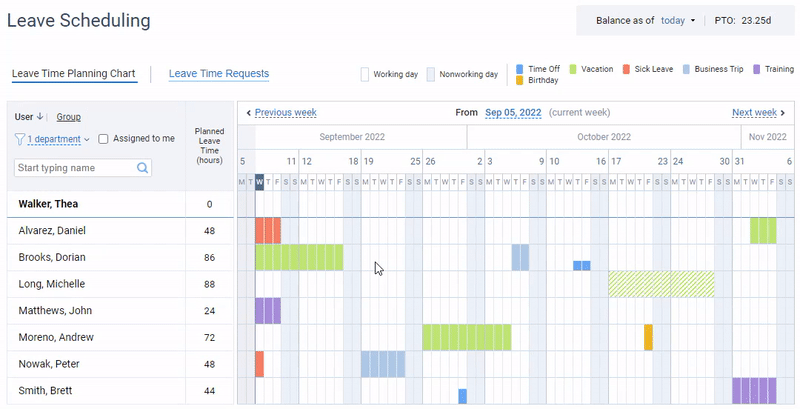
Use actiPLANS to stay in the know of employees’ available leave balances, track staff availability, and schedule work with ease.
Step 4: Automate the leave request process
Automating the leave request process ensures that employees can swiftly and discreetly request the time off they need, reducing the emotional burden during an already difficult period. This is where actiPLANS shines as a top-tier solution, offering a seamless experience for managing a diversity of leave types, including bereavement.
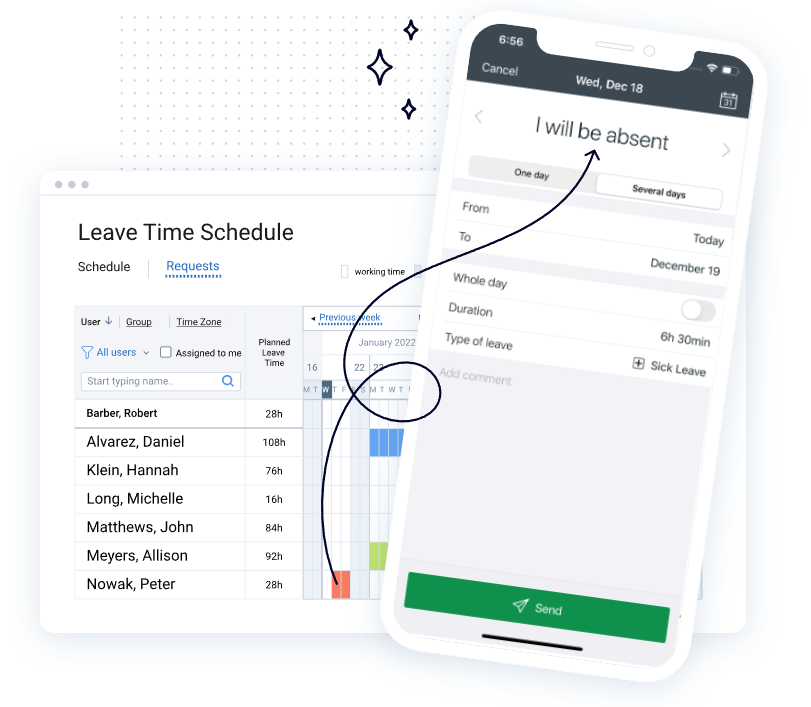
actiPLANS makes it easy to create custom leave types and accrual rules. This means you can tailor the system to match your company’s specific policies and needs, ensuring fair and consistent leave management.
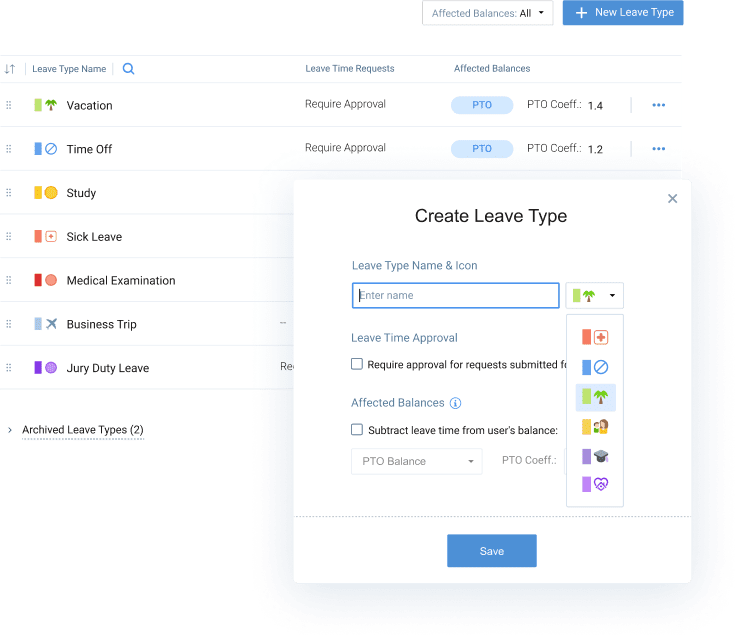
Self-service functionality with an intuitive visual timeline lets employees easily view their earned leave balances, track their leave history, and schedule time off with just a few clicks. Besides, using the mobile app, they can manage leave requests from pretty much any location.
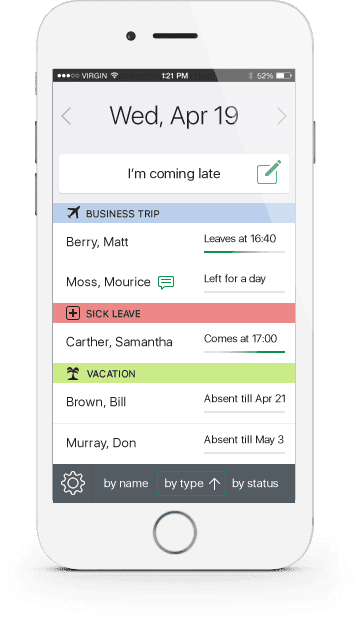
Automated leave request approval comes in handy too. With the help of this feature, you can say goodbye to the back-and-forth emails and manual tracking – requests are routed to the appropriate manager, who can approve or deny them in real time. Moreover, you can automate the approval of specific leave types entirely (which is particularly appropriate in case of bereavement leave).
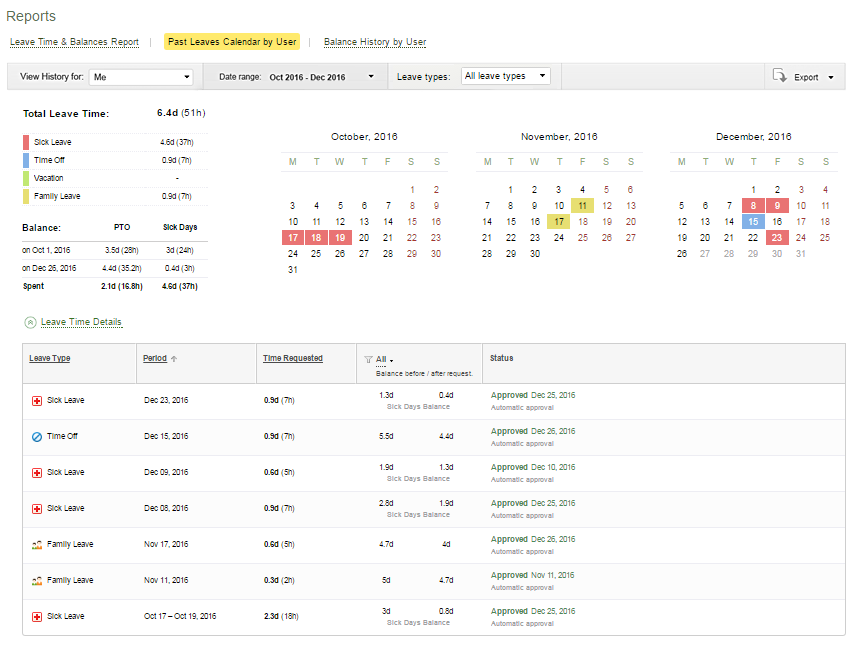
actiPLANS simplifies the entire process of managing any kind of leave, providing you and your employees with more time to focus on what truly matters.
Sign up for a free 30-day trial here.
FAQs About Bereavement Leave
What is meant by bereavement leave?
Bereavement leave is a special type of time off granted to employees when they experience the death of a loved one. It’s an essential support system during a time when emotions can be overwhelming, and the last thing you want to worry about is work.
Typically, companies offer a few days to a week of bereavement leave, giving employees the space to attend funeral services, handle family affairs, and process their loss. On the part of an employer, it is a compassionate gesture, acknowledging that life happens and sometimes a person just needs a break to grieve and heal.
How long does bereavement leave usually take?
Bereavement leave policies can vary significantly depending on the employer and the local laws. Typically, bereavement leave lasts between 3 to 5 days, allowing employees time to grieve and make necessary arrangements following the loss of a loved one.
Some companies may offer additional leave or flexible arrangements for employees who require more time.
It’s important for employees to consult their employee handbook or HR department for specific policies and any applicable state or federal regulations regarding bereavement leave.
What’s the difference between bereavement leave and compassionate leave?
Bereavement leave is reserved for those cases when someone has lost a loved one, giving you that crucial time to grieve and handle arrangements without the added stress of work.
On the other hand, compassionate leave is a bit broader. It covers a range of scenarios where you might need time off to care for a sick family member, deal with a serious personal issue, or provide support during distressing times.
In sum, while bereavement leave is typically restricted to death, compassionate leave is more flexible, and aimed at supporting you through various tough situations, whether that’s coping with a divorce, looking after a terminally ill relative, or even just needing a mental health break due to overwhelming circumstances.
If my company doesn’t provide bereavement leave, what are my options?
In this case, you can do one of the following things:
- First, check your employee handbook for any policies on unpaid leave. You might be eligible for a leave of absence that allows you some time off to grieve without the added pressure of work obligations.
- Consider the FMLA leave. This federal law allows employees to take up to 12 weeks of unpaid leave for specific family-related issues, including the death of a close family member. While it isn’t specifically labeled as bereavement leave, you can still use it to manage your family-related matters in case you meet the eligibility criteria.
- Another route is to tap into your vacation or personal days – many employers will let you use these for bereavement if you’re transparent about your situation.
- Have a chat with your manager or HR – they might be open to a flexible work arrangement that accommodates your needs, allowing you to ease back into your responsibilities at your own pace.
Is it beneficial for employers to provide bereavement leave to employees?
Absolutely! Providing bereavement leave can be incredibly beneficial for employers and their employees alike.
The loss of a loved one is a deeply personal and often overwhelming time. Granting employees time off during this period not only shows compassion but also acknowledges the emotional toll that bereavement can have. This, in turn, cultivates a supportive workplace culture, fostering loyalty and trust.
Employers who offer bereavement leave often see improved employee morale and productivity in the long run. Moreover, it can enhance the company’s reputation, making it a more attractive place for potential talent.
Conclusion
Bereavement leave management can be daunting, but with a firm understanding of all the relevant laws and a compassionate approach, you’re well-equipped to support your employees during their most challenging times.
Remember, every situation is unique, and flexibility can go a long way in showing that you truly care about your team’s well-being. By staying empathetic, responsive, and informed about bereavement leave laws you can turn a complex issue into a cornerstone of your company’s positive culture.



